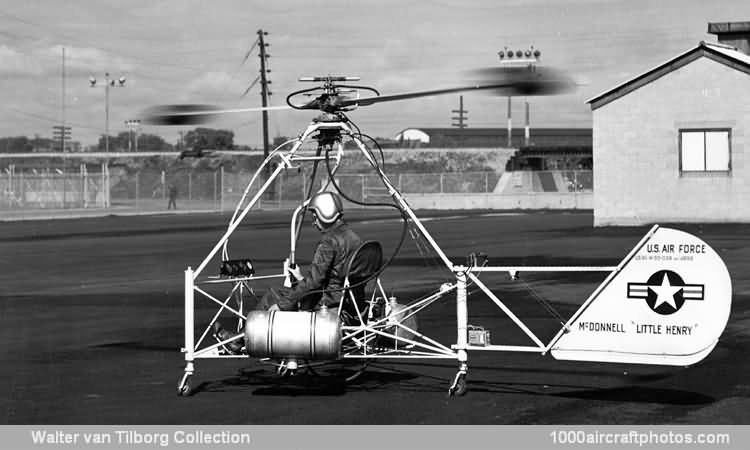12/31/2009. Remarks by Johan Visschedijk: "The diminutive XH-20 was developed by a team led by Marvin Marks in close co-operation between the Helicopter and Propulsion Division of McDonnell and the USAAF/USAF Rotor Wing Branch, Propeller Laboratory and Rotary Wing Unit, Aircraft Projects Section, Wright-Patterson AFB.
At the time of its inception, the XH-20 was unique in being powered by two McDonnell-developed 7.25 in (18.42 cm) ramjet units weighing only 10 lb (4.5 kg) each, mounted at the tips of the two-blade rotor and fed from tanks beside the pilot. The fuel, originally propane but later replaced by motorcar petrol, was boosted through a feed line to a specially designed delivery valve on the rotor head. From there the centrifugal force of the rotor took over to convey the fuel through the blades to the tip-mounted ramjets.
When in July 1946 McDonnell was awarded an USAAF contract for the development and testing of two experimental machines (initially designated XR-20, redesignated XH-20 in 1947), it was hoped that the novel power plant would make it feasible to build small, light-weight helicopters by reducing or eliminating complex and heavy engine parts, gear systems and transmissions.
Furthermore, it was claimed that this power plant installation would result in increased efficiency and would completely eliminate torque, thus making the conventional anti-torque tail rotor unnecessary. Accordingly, the two XH-20s were ordered as flying test beds and were not intended as production prototypes.
The airframe was kept as simple as possible and consisted of welded tubes carried on three vertical legs ending with fully castoring wheels. Conventional helicopter controls were fitted and the pitch lever incorporated a motorcycle-type throttle to regulate the fuel flow.
Fitted as a single-seater, the first of two prototypes (s/n 46-689 and 46-690) was initially flown at St.Louis on May 5, 1947, with C.R. Woods at the controls. Tests continued until the early fifties, by which time one of the
XH-20s had been modified as a two-seater, and proved generally satisfactory.
However, the ramjet units had excessive fuel consumption, which drastically limited range and endurance when compared to conventionally-powered helicopters, and McDonnell was forced to abandon further development.
The first XH-20 was preserved and is now part of the collection of the National Museum of the USAF, Wright-Patterson AFB, Ohio, USA."
